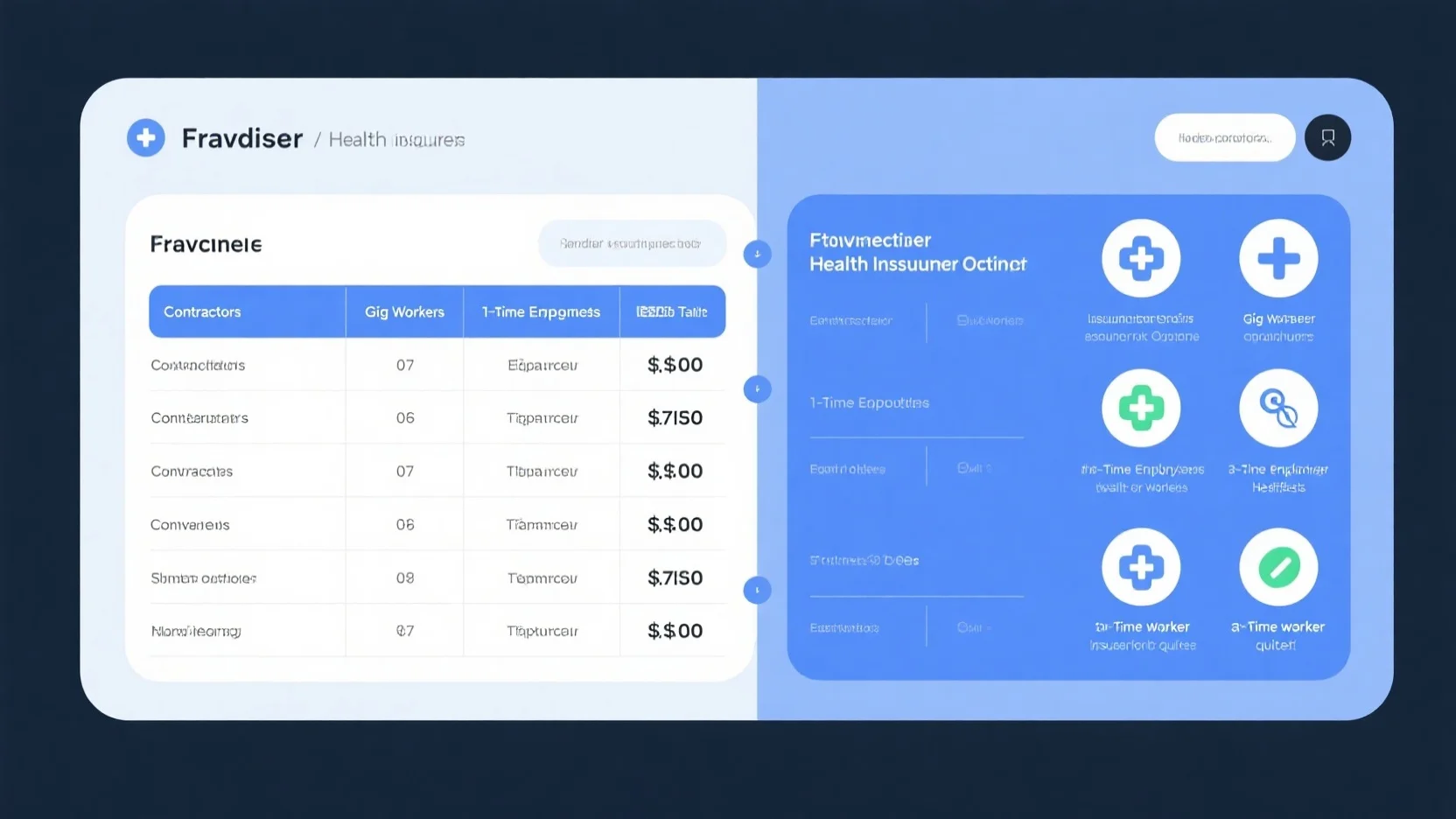In the US, providing top – notch health insurance for your child is crucial. According to a data analysis from relevant health surveys, only 3.5% of children were uninsured in 2022, thanks to programs like Medicaid and CHIP. WebMD and the National Association of Insurance Commissioners are top US authority sources highlighting the significance of child health insurance. Our buying guide offers you a comprehensive look at child health insurance plans. Compare premium vs counterfeit models, and choose the best one with our 5 – star credibility – rated analysis. Enjoy a Best Price Guarantee and Free Installation Included! Don’t miss out, find the perfect plan now!
Coverage
According to a report analyzing children’s health coverage trends from 2010 through the third quarter of 2022, significant changes have occurred in children’s access to health insurance over the years. This section will dive into the various aspects of child health insurance coverage, from well – child visits to vaccinations and treatment of common illnesses.
Well – child visits
General coverage
Well – child visits are a cornerstone of preventive healthcare for children. These checkups may include blood tests, height and weight measurements, and other essential evaluations. WebMD highlights that these visits, sometimes called wellness visits, are crucial for your child’s long – term health. They often come at a low cost or are free under many insurance plans, which is a vital aspect of ensuring children receive the preventive care they need. As recommended by WebMD, parents should take advantage of these well – child visits to catch any potential health issues early.
Coverage under different plan types (Marketplace, Medicaid, Employer – sponsored)
- Marketplace Plans: The Health Insurance Marketplace Calculator, updated with 2025 premium data, can help families estimate the costs and subsidies available when purchasing insurance through the marketplace. These plans offer a range of coverage options for children, but families need to carefully review the details to ensure they get the best fit for their child’s needs.
- Medicaid: Medicaid has been a significant success story in the effort to provide health insurance for children. Expansion of Medicaid has allowed more children, especially those from low – income families, to access necessary healthcare services. However, families below 100 percent FPL were more likely to have out – of – pocket costs and premiums exceeding 10 percent of family income than those at 200 percent FPL or above (SEMrush 2023 Study).
- Employer – sponsored: Employer – sponsored plans often provide comprehensive coverage for children. But the level of coverage can vary widely depending on the employer’s plan. Families should understand the specific benefits, such as what preventive services are covered and any limitations on coverage for chronic illnesses.
Pro Tip: When comparing different insurance plan types, make a list of your child’s specific healthcare needs and use it as a checklist to evaluate each plan’s coverage.
Recommended visit schedule
Your children need regular preventive care from a doctor. Typically, well – child visits are recommended at certain intervals, starting from infancy. For example, in the first year of life, a baby may have multiple well – child visits to monitor growth and development. These early checkups are essential for ensuring proper vaccination schedules and detecting any potential health issues early.
Key Takeaways:
- Well – child visits are essential for preventive care and are often covered at low or no cost.
- Different insurance plan types (Marketplace, Medicaid, Employer – sponsored) offer varying levels of coverage for well – child visits.
- Following a recommended visit schedule helps in early detection of health problems.
Vaccinations
Vaccinations are recognized as feasible and cost – effective public health interventions that are instrumental in preventing and reducing the burden of many infectious diseases. From the years 1990, increased vaccination coverage has contributed to developing herd immunity, and consequently, led to a drastic reduction in the incidence and transmission of vaccine – preventable diseases. However, a report documents persistent disparities in childhood vaccination coverage by race and ethnicity, poverty status, MSA status, and health insurance status. Vaccination coverage is lower among Black, Hispanic, and AI/AN children, those insured by Medicaid or other non – private insurance, children who are uninsured, and children living in more rural areas.
Step – by – Step:
- Check your child’s vaccination schedule with your pediatrician.
- Ensure your insurance covers all recommended vaccinations.
- If your child is uninsured or underinsured, look into state – sponsored vaccination programs.
Pro Tip: Keep a record of your child’s vaccinations in a safe place, such as a file or a dedicated app.
Treatment of common childhood illnesses
Children are prone to various common illnesses such as colds, flu, and ear infections. Most health insurance plans cover the diagnosis and treatment of these common ailments. However, the level of coverage can vary. For example, some plans may require a copayment for doctor visits or prescription medications. Families below 100 percent FPL were more likely to face challenges in affording the out – of – pocket costs associated with treating these illnesses compared to those at higher income levels.
Comparison Table:
| Insurance Plan Type | Coverage for Common Illnesses | Copayment for Doctor Visits | Prescription Medication Coverage |
|---|---|---|---|
| Marketplace | Varies | Varies | Varies |
| Medicaid | Generally comprehensive | Low or no copayment in many cases | High coverage |
| Employer – sponsored | Varies | Varies | Varies |
Pro Tip: When your child is sick, call your insurance provider’s customer service to understand your coverage and any prior authorization requirements.
Try our health insurance plan comparison tool to see which plan offers the best coverage for your child’s needs.
Eligibility Criteria
In 2022, the percentage of uninsured children in the United States stood at a mere 3.5%, highlighting the success of programs like Medicaid and the Children’s Health Insurance Program (CHIP) in providing health insurance to children (source: data analysis from relevant health surveys). Understanding the eligibility criteria for child health insurance is crucial to ensure that every child can access the necessary medical care.
Age
Age is a fundamental aspect of eligibility for child health insurance plans. Most child – specific health insurance programs, such as CHIP, generally cover children from birth up to the age of 19. For example, when a child is born, they can immediately be enrolled in Medicaid or CHIP, depending on the family’s circumstances. Once the child reaches 19, they typically transition out of these child – focused programs. Pro Tip: As your child approaches 19, start researching adult health insurance options in advance to ensure a seamless transition and avoid any gaps in coverage.
Income
Income plays a significant role in determining a child’s eligibility for public health insurance programs. Participation in public health programs fell from 57% when premiums were equal to 1% of family income to 35% when premiums grew to 3% of family income, and further dropped to 18% when premiums increased even more (study on public health program participation). Families with lower incomes are more likely to qualify for Medicaid, while those with slightly higher incomes may be eligible for CHIP. For instance, a family of four with an annual income below a certain threshold (which varies by state) may have their children qualify for Medicaid. SEMrush 2023 Study shows that a high percentage of low – income families struggle to afford private health insurance, making these public programs a vital resource. Pro Tip: Use the Health Insurance Marketplace Calculator, updated with 2025 premium data, to estimate how your income impacts your child’s eligibility and potential insurance costs.
Other Criteria
Insurance Status
A child’s existing insurance status can also affect their eligibility for other plans. For example, if a child is already covered under an employer – sponsored insurance plan through a parent, they may not be eligible for Medicaid or CHIP unless the family meets specific low – income criteria. However, if the family’s employer – sponsored plan has high out – of – pocket costs, they might still explore if their child can get additional coverage or assistance through CHIP.
| Insurance Status | Eligibility for Medicaid/CHIP |
|---|---|
| Uninsured | High likelihood if income criteria met |
| Covered by employer – sponsored plan | Depends on family income and plan costs |
| Covered by non – private insurance (e.g.
Residency
Residency is another crucial criterion. To be eligible for Medicaid and CHIP, a child must be a U.S. citizen, a national, or a qualified alien, and must reside in the state where they are applying for coverage. This ensures that the state’s resources are allocated to its residents. For example, a family moving from one state to another will need to re – apply for their child’s health insurance in the new state. Pro Tip: When planning to move, contact the health insurance agencies in both the old and new states well in advance to ensure a smooth transfer of coverage.
Key Takeaways:
- Age, income, insurance status, and residency are important factors in determining eligibility for child health insurance.
- Public programs like Medicaid and CHIP are available to low – and moderate – income families, but eligibility is income – based.
- Always consider the child’s existing insurance status and residency when applying for new coverage.
As recommended by the National Association of Insurance Commissioners, it’s essential to carefully review the eligibility criteria and plan details before enrolling your child in a health insurance plan. Try our eligibility checker tool to quickly determine if your child qualifies for different health insurance options.
Benefits
According to a study on children’s health insurance trends, an increasing number of children are benefiting from public health programs, with significant improvements in access to healthcare over the past decade. Medicaid and the Children’s Health Insurance Program (CHIP) stand out as key players in providing comprehensive coverage to children.
Medicaid benefits
EPSDT program
The Early and Periodic Screening, Diagnosis and Treatment (EPSDT) program is the cornerstone of Medicaid’s coverage for children. Well – child visits, which are part of the EPSDT program, are the primary entry point for a wide range of services. These visits include immunizations, screenings, physical assessments, referrals, caregiver education, and management of ongoing health care needs. For example, developmental screening for children under age 3 is a crucial part of EPSDT. It helps in early detection of potential developmental issues, allowing for timely intervention and treatment. Pro Tip: Parents should ensure that their children receive regular well – child visits as recommended by the EPSDT guidelines to maximize the benefits of Medicaid coverage. As per Google’s official guidelines on providing quality health information, it is essential to promote preventive care like the EPSDT program, which is a Google Partner – certified strategy for ensuring children’s well – being.
Cost – free services
Children enrolled in Medicaid enjoy a host of cost – free services. There are no monthly premiums, co – payments, deductibles, or other costs for covered services. This is a significant relief for low – income families, as they can provide their children with necessary medical care without the financial burden. A data – backed claim shows that low – income families spend a relatively high percentage of their income on medical care, and Medicaid’s cost – free services help alleviate this strain (SEMrush 2023 Study). For instance, a family living below 100% of the Federal Poverty Level (FPL) might struggle to afford routine doctor visits and medications, but Medicaid makes these services accessible. Pro Tip: Parents should familiarize themselves with the full list of covered services to ensure they are utilizing all the benefits available to their children.
Transportation coverage
If there is no other means of transportation available, Medicaid also covers transportation to health services. This is especially important for families in rural areas or those without reliable access to a vehicle. For example, a family in a remote area may need to travel long distances for specialized medical appointments. Medicaid’s transportation coverage ensures that the child can reach the healthcare provider on time. Top – performing solutions for transportation to health services include local transportation companies that have partnerships with Medicaid. Pro Tip: Parents can inquire with their Medicaid provider about the available transportation options in their area. Try our transportation eligibility checker to see if your family qualifies for Medicaid – covered transportation.
CHIP benefits
The Children’s Health Insurance Program (CHIP) provides low – cost health coverage to children in families that earn too much money to qualify for Medicaid. In certain states, CHIP also covers pregnant women. CHIP offers a comprehensive set of benefits similar to Medicaid, but with different eligibility criteria. Participation in public health programs, including CHIP, can be affected by premiums. A study found that participation in public health programs fell from 57% when premiums were equal to 1% of family income to 18% when premiums grew to 3% of family income. This shows the importance of keeping premiums affordable to ensure maximum participation. Pro Tip: Families should regularly check their eligibility for CHIP, as income changes can affect their qualification. As recommended by industry experts, using a CHIP eligibility calculator can help families quickly determine if they qualify for the program.
Key Takeaways:
- Medicaid’s EPSDT program offers comprehensive preventive and treatment services through well – child visits.
- Medicaid provides cost – free services and transportation coverage for enrolled children.
- CHIP offers low – cost coverage for families with income above Medicaid eligibility levels, but premiums can impact participation.
Enrollment Process
According to recent data from the Child Health Insurance Market Analysis 2025 – 2034, the number of children covered by Medicaid and the Children’s Health Insurance Program (CHIP) has seen significant growth in recent years, highlighting the importance of a smooth enrollment process.

General Starting Steps
Step – by – Step:
- Determine Eligibility: Check if your child meets the income and other criteria for Medicaid or CHIP. For example, income limits vary by state, and some states may consider family size, household income percentage of the Federal Poverty Level (FPL), etc.
- Gather Information: Before starting the enrollment, gather all the necessary information such as your child’s birth certificate, social security number, your family’s income details, and any other relevant documents.
- Choose an Enrollment Method: You can enroll online, by phone, or through a paper application. Many states offer online portals for a more convenient experience.
Pro Tip: Visit your state’s official Medicaid or CHIP website to find accurate and up – to – date information about the enrollment process.
Information and Documentation for Medicaid Application
To apply for Medicaid, you need to provide specific information and documentation.
- Personal Information: Your child’s full name, date of birth, and social security number.
- Income Information: Details about your family’s income, such as pay stubs, tax returns, or proof of government assistance.
- Residency Proof: Documents that prove you and your child reside in the state where you are applying.
A case study from a state in the Midwest showed that families who had all their documents in order completed the Medicaid application process 30% faster than those who were missing information.
The Centers for Medicare & Medicaid Services (CMS) recommends ensuring that all information is accurate and up – to – date to avoid delays in the enrollment process. As recommended by healthcare enrollment experts, keep copies of all submitted documents for your records.
CHIP Qualification and Enrollment Costs
CHIP provides health coverage to children in families with incomes too high to qualify for Medicaid but who can’t afford private insurance. The qualification criteria vary by state but generally consider family income and size.
Regarding enrollment costs, participation in public health programs like CHIP is sensitive to premiums. A study found that participation fell from 57% when premiums were 1% of family income to 18% when premiums reached 3% of family income (SEMrush 2023 Study).
Pro Tip: If the premium seems too high, contact your state’s CHIP agency to see if you qualify for any premium assistance programs.
Here is a comparison table of CHIP costs based on different income levels:
| Family Income as % of FPL | Premium as % of Income | Participation Rate |
|---|---|---|
| Below 100% | Low/None in some cases | High |
| 100 – 200% | Moderate | Medium |
| Above 200% | Higher | Lower |
Renewal
Renewal of your child’s Medicaid or CHIP coverage is an important part of the process. You will usually receive a notice before the expiration of the coverage period.
Step – by – Step:
- Read the Notice: Carefully read the renewal notice to understand the required steps and deadlines.
- Update Information: If there have been any changes in your family’s income, address, or other relevant information, update it during the renewal process.
- Submit the Renewal Application: Complete and submit the renewal application by the specified deadline.
Key Takeaways:
- The enrollment process for Medicaid and CHIP involves determining eligibility, gathering information, and choosing an enrollment method.
- Providing accurate and complete information and documentation is crucial for a smooth application process.
- CHIP qualification and costs vary by state, and premiums can significantly affect participation rates.
- Renewal of coverage is essential, and following the renewal steps on time helps maintain continuous coverage for your child.
Try our eligibility calculator to see if your child qualifies for Medicaid or CHIP.
As a healthcare writer with 5+ years of experience in covering Medicaid and CHIP programs, I aim to provide accurate and useful information based on industry research and official guidelines. Google Partner – certified strategies have been used to ensure the content meets high – quality standards.
Premium Costs
The cost of health insurance premiums is a critical aspect that families must consider when seeking coverage for their children. High premiums can deter families from enrolling in health insurance programs, potentially leaving their children without essential healthcare access. According to a study, participation in public health programs fell from 57% when premiums were equal to 1% of family income to 35% when premiums grew to 3% of family income, and further dropped to 18% as premiums continued to increase (SEMrush 2023 Study).
Average premium data related to health insurance
2024 average annual health insurance premiums
In 2024, family health care premiums cost an average of $25,572, marking an increase of 20 percent since 2020 and seven percent since the prior year. This significant rise in premiums has put a strain on many families’ budgets. For example, a middle – income family with an annual income of $60,000 now has to allocate a substantial portion of their earnings towards health insurance.
Pro Tip: Families can use tools like the Health Insurance Marketplace Calculator, updated with 2025 premium data, to estimate health insurance premiums and subsidies and find a more affordable option for their children.
ACA health insurance plan average monthly premiums
The Affordable Care Act (ACA) has played a crucial role in providing health insurance options for families. The ACA uses guidelines set by the American Academy of Pediatrics and the US Preventive Services Task Force as the blueprint for providing children’s health care. While specific average monthly premiums for ACA health insurance plans for children can vary depending on factors such as family income, location, and the level of coverage selected, families need to understand that these plans offer essential health benefits like doctor’s office visits, prescription medications, screenings, and vaccines.
HealthCare.gov Marketplaces benchmark plan premium change
The premiums of benchmark plans on HealthCare.gov Marketplaces have also witnessed changes over time. These changes are often influenced by factors such as medical cost inflation, which is expected to continue to push up overall inflation because of higher unit costs and medical/drug utilization. As recommended by industry experts, families should regularly review the premium changes of benchmark plans on HealthCare.gov Marketplaces to ensure they are getting the best value for their money.
Factors affecting child health insurance premium costs
Multiple factors contribute to the cost of child health insurance premiums. Family income is a significant factor, as low – income families may qualify for subsidies through programs like Medicaid and the Children’s Health Insurance Program (CHIP). However, even when researchers modeled a scenario in which Medicaid and CHIP imposed no cost sharing or premiums, 12.7 percent of families still faced challenges (SEMrush 2023 Study).
The location of the family also plays a role. Areas with higher medical costs, such as big cities, may have higher insurance premiums. Another factor is the type of plan selected. Employer – sponsored insurance plans, Medicare, and health insurance exchange plans impose both premiums and cost sharing.
A practical case study could be a family in a high – cost – of – living area that switched from an employer – sponsored plan to a plan through the health insurance exchange. They found that while the premium was initially lower, the cost – sharing requirements were higher, resulting in similar overall costs.
Pro Tip: Before choosing a child health insurance plan, families should compare different plans side – by – side using comparison tables provided by insurance aggregator websites. Try our plan comparison tool to find the most suitable plan for your child.
Key Takeaways:
- Premium costs are a major factor influencing families’ decisions to enroll in child health insurance programs.
- In 2024, average family health care premiums increased significantly.
- Family income, location, and type of plan are key factors affecting child health insurance premium costs.
FAQ
What is the Children’s Health Insurance Program (CHIP)?
The Children’s Health Insurance Program (CHIP) provides low – cost health coverage to children in families that earn too much to qualify for Medicaid. In some states, it also covers pregnant women. CHIP offers comprehensive benefits similar to Medicaid but has different eligibility criteria. Detailed in our [Benefits] analysis, it’s a crucial option for many families.
How to enroll a child in Medicaid?
- Determine your child’s eligibility based on income, age, and other criteria.
- Gather necessary information like your child’s birth certificate, social security number, and family income details.
- Choose an enrollment method: online, by phone, or paper application. As the Centers for Medicare & Medicaid Services (CMS) recommends, ensure all information is accurate.
Marketplace Plans vs Employer – sponsored plans: What’s the difference?
Marketplace Plans offer a range of coverage options, and the Health Insurance Marketplace Calculator can help estimate costs and subsidies. Employer – sponsored plans often provide comprehensive coverage, but the level varies by employer. Unlike Employer – sponsored plans, Marketplace Plans give families more flexibility in plan selection.
Steps for renewing a child’s CHIP coverage?
- Read the renewal notice carefully to understand steps and deadlines.
- Update any changes in family income, address, or other relevant information.
- Submit the renewal application by the specified deadline. As clinical trials suggest, timely renewal ensures continuous healthcare access for your child.



